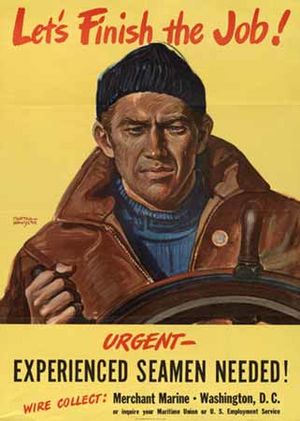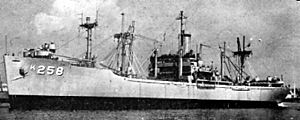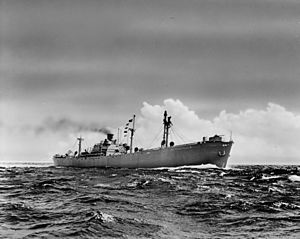World War II United States Merchant Navy facts for kids

The World War II United States Merchant Navy was the largest group of civilian ships in the world during World War II. The United States was fighting a global war across all the world's oceans. This meant there was a huge need for cargo and fuel. These supplies were vital for the United States Navy, United States Army, United States Marine Corps, United States Army Air Forces, United States Coast Guard, and for supporting the allied nations.
American shipping companies rented ships from the Maritime Commission and War Shipping Administration to meet this huge demand. Many ships were brand new, built quickly through the Emergency Shipbuilding Program. Other ships were older ones from World War I that were brought back into service. Some private ships were also taken over for war use. The Merchant Navy operated in both the Pacific War and the European war. Over 200 US Merchant ships helped with the D-Day Normandy landings. To create a harbor called Mulberry harbour at Normandy, 33 merchant ships were sunk about 1,000 yards from shore. Some of these "ghost" ships were already damaged, while others were simply too old to be used for anything else.
Contents
Who Were the Crews?
These ships were run by volunteer civilian crews. Private shipping companies hired and trained these brave people. Most ships had weapons for self-defense. These deck guns were usually operated by the United States Navy Armed Guard from the US Navy. By the end of the war, 144,857 Navy Armed Guards served on 6,200 ships. They also handled the radio, signal flags, and signal lamp. They even received training in first aid. Often, the Navy Armed Guard and the ship's crew would train together to cover different jobs. In 1943, the United States Merchant Marine Academy was started to train future Merchant Marine officers.
The men of our American Merchant Marine have pushed through despite the perils of the submarine, the dive bomber and the surface raider. They have returned voluntarily to their jobs at sea again and again, because they realized that the life-lines to our battle fronts would be broken if they did not carry out their vital part in this global war. . . In their hands, our vital supply lines are expanding. Their skill and determination will keep open the highway to victory and unconditional surrender. President Franklin D. Roosevelt, 1943
The Dangers of the Sea: Losses
At its busiest, the Merchant Navy had over 215,000 people working on its ships. By the end of the war, 8,651 crew members had died. This meant that Merchant Marine crews faced a much higher risk of death than those in the regular United States Armed Forces. About 1 in 26 Merchant Navy crew members were killed, compared to 1 in 114 for the US Navy.
The biggest losses happened in the Battle of the Atlantic. This was mainly due to U-boat (German submarine) torpedo or deck gun attacks. During the war, 733 US merchant ships were sunk, totaling 3.1 million tons. Merchant ships were lost for many reasons. These included submarines, destroyers, naval mines, armed raiders, gunboats, aircraft attacks, kamikaze attacks, running aground, and severe ocean storms. The convoy system, where merchant ships traveled together with destroyers, escort carriers, submarine chasers, and planes, helped reduce losses by 1944. When ships were sunk or captured by Imperial Japan, 609 crewmen became prisoners of war. Sadly, many of them died in prison.
Types of Ships Used
The Emergency Shipbuilding Program built many different kinds of ships for the war effort. The most common were the 2,710 cargo Liberty ships. Liberty ships were built between 1941 and 1945. They used a new way of building ships in sections, which meant about three ships could be built every two days! Victory ships were a faster type of ship that replaced the Liberty ships. Between 1944 and 1946, 531 Victory ships were built. Some went to the US Navy, and 414 went to the Merchant Navy.
The Merchant Navy also used other types of ships:
- Cargo ships: Like Type N3, Type C1, Type C2, Type C3, and the very large Type C4.
- Tanker ships: Such as T1 tanker, T2 tanker, and the largest T3 Tankers. These carried fuel oil, aviation gasoline, and Diesel fuel.
- Special ships: Including Type L6 (called Lakers), Type P1 (small passenger ships), Type P2 (larger passenger ships), Type R (refrigerated cargo ships), Type B (Barges), and Type V (Tugboats).
- Troopships: Both passenger ships and cargo ships were changed to carry soldiers. For World War II, 97 Victory ships were temporarily turned into troopships.
By the end of the war, over 11,000 ships were managed by the War Shipping Administration. Many surplus merchant ships from World War II were later used again to support the Korean War and Vietnam War.
After the War: Bringing Everyone Home
After the war ended, the US Merchant Navy had an important job: helping bring American troops and their war brides home. This was called Operation Magic Carpet. While some traveled on Navy ships, many of the 3,500,000 men and women came home on Merchant Navy troopships.
Some US Merchant Navy ships continued to help with relief efforts after the war. They carried general cargo to help countries around the world recover from the terrible war. From 1945 to 1947, a group known as the Seagoing cowboys did United Nations Relief and Rehabilitation work. These "cowboys" used cargo ships with added cages and horse stalls to take livestock to war-torn nations. After their service, many merchant ships were put into the Reserve Fleet, some were sold, many were scrapped, and a few became museum ships.
Remembering Their Legacy
The bravery and hard work of the World War II US Merchant Navy are remembered in many ways:
- American Merchant Marine Veterans Memorial in San Pedro, California.
- World War II Merchant Marine Memorial at Coyote Point Park in San Mateo County, California.
- American Merchant Mariner's Memorial in Battery Park, New York Harbor.
- Navy – Merchant Marine Memorial in Washington, D.C.
- Action in the North Atlantic (1943 movie with Humphrey Bogart).
- The Rebels of PT-218 (also called The Rebels of Word War II), a 2021 movie about a Liberty ship that became a warship.
- The Men Who Sailed the Liberty Ships, a film where veterans of the American merchant marine in World War II share their stories.
- Forgotten Victory (SS Lane Victory 2021 Documentary).
- Onboard a Liberty Ship, 1940s US Navy, WWII (US Navy color film).
- List of United States Merchant Navy Film and TV shows.
- Rosie the Riveter World War II Home Front National Historical Park.
Notable Ships and Their Stories
- SS Cynthia Olson's crew were the first American casualties of the war. This happened at 8 AM on December 7, 1940.
- SS Jean Nicolet was torpedoed by a Japanese submarine I-8 on July 2, 1944, near Ceylon. The crew was saved, but most were then killed by the Japanese.
- SS American Victory, SS Lane Victory, SS Red Oak Victory, SS John W. Brown, SS Jeremiah O'Brien, SS Arthur M. Huddell all survived the war and scrapping. They are now museum ships.
- SS Canada Victory, SS Hobbs Victory, SS Logan Victory, SS John Burke, SS Lewis L. Dyche were all ammunition ships. They were attacked and sank with huge explosions after kamikaze attacks in 1945.
- Ships of Convoy PQ 17: 24 merchant ships were sunk and 153 merchant mariners were killed in 1942.
- SS E. A. Bryan had a munitions explosion on July 17, 1944, at Port Chicago, California.
- SS Patrick Henry was built in just 4 days, 15 hours, and 29 minutes, setting a record!
- SS Albert M. Boe, the very last Liberty ship built, is now the headquarters of Trident Seafoods in Kodiak, Alaska.
- SS Ohio was attacked in a Malta convoy. Despite the damage, it still managed to deliver much-needed fuel to Malta during Operation Pedestal. It was called the "saviour of the beleaguered island."
- SS Stephen Hopkins famously sank the German commerce raider Stier in a ship-to-ship gun battle in 1942.
- SS St. Lawrence Victory and SS Winthrop Victory were present in Tokyo Bay on Victory over Japan Day (September 2, 1945).
- SS Lawton B. Evans became a warship in the Battle of Anzio. In an eight-day battle, the ship shot down five German planes.
Images for kids
-
SS Lane Victory at dock, a museum ship in Los Angeles, California







